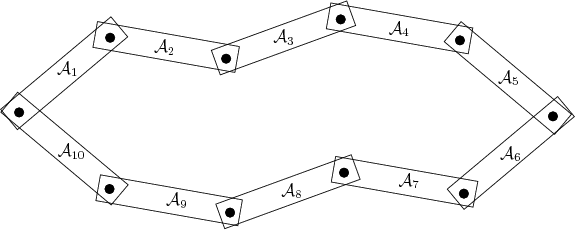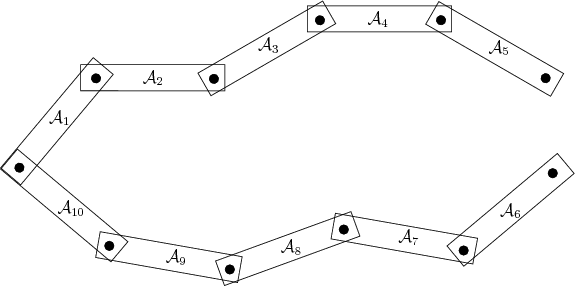
Next: 3.5 Nonrigid Transformations Up: 3.4 Transforming Kinematic Trees Previous: Constraining parameters
 |
The most general case includes links that are connected in loops, as shown in Figure 3.26. These are generally referred to as closed kinematic chains. This arises in many applications. For example, with humanoid robotics or digital actors, a loop is formed when both feet touch the ground. As another example, suppose that two robot manipulators, such as the Puma 560 from Example 3.4, cooperate together to carry an object. If each robot grasps the same object with its hand, then a loop will be formed. A complicated example of this was shown in Figure 1.5, in which mobile robots moved a piano. Outside of robotics, a large fraction of organic molecules have flexible loops. Exploring the space of their conformations requires careful consideration of the difficulties imposed by these loops.
 |
The main difficulty of working with closed kinematic chains is that it
is hard to determine which parameter values are within an acceptable
range to ensure closure. If these values are given, then the
transformations are handled in the same way as the case of trees. For
example, the links in Figure 3.26 may be transformed by
breaking the loop into two different chains. Suppose we forget that
the joint between
![]() and
and
![]() exists, as shown in Figure
3.27. Consider two different kinematic chains that start
at the joint on the extreme left. There is an upper chain from
exists, as shown in Figure
3.27. Consider two different kinematic chains that start
at the joint on the extreme left. There is an upper chain from
![]() to
to
![]() and a lower chain from
and a lower chain from
![]() to
to
![]() . The
transformations for any of these bodies can be obtained directly from
the techniques of Section 3.3.1. Thus, it is easy to
transform the bodies, but how do we choose parameter values that
ensure
. The
transformations for any of these bodies can be obtained directly from
the techniques of Section 3.3.1. Thus, it is easy to
transform the bodies, but how do we choose parameter values that
ensure
![]() and
and
![]() are connected at their common joint? Using
the upper chain, the position of this joint may be expressed as
are connected at their common joint? Using
the upper chain, the position of this joint may be expressed as
In general, a complicated arrangement of links can be imagined in which there are many loops. Each time a joint along a loop is ``ignored,'' as in the procedure just described, then one less loop exists. This process can be repeated iteratively until there are no more loops in the graph. The resulting arrangement of links will be a tree for which the previous techniques of this section may be applied. However, for each joint that was ``ignored'' an equation similar to (3.81) must be introduced. All of these equations must be satisfied simultaneously to respect the original loop constraints. Suppose that a set of value parameters is already given. This could happen, for example, using motion capture technology to measure the position and orientation of every part of a human body in contact with the ground. From this the solution parameters could be computed, and all of the transformations are easy to represent. However, as soon as the model moves, it is difficult to ensure that the new transformations respect the closure constraints. The foot of the digital actor may push through the floor, for example. Further information on this problem appears in Section 4.4.
Steven M LaValle 2020-08-14